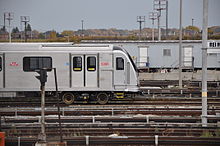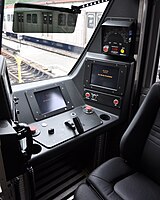Toronto Rocket
| Toronto Rocket | |
|---|---|
 Toronto Rocket train at St. George station | |
| In service | 2011–present |
| Manufacturer | Bombardier Transportation |
| Built at | Thunder Bay, Ontario |
| Family name | Movia |
| Replaced | H4, H5, H6 (phase out occurring as more new trains enter service) |
| Constructed | 2008–present |
| Number under construction | 70 six-car trains ordered[1][2] 56 train sets yet to be delivered |
| Number built | 19 trains (5381-5566) |
| Number in service | 15-18 trains (as of June 2012) |
| Formation | 6-car permanently mated sets |
| Fleet numbers | 5381-6076[3] (based off from retired TTC vehicles, H1, H2, H4, H5, H6 subway trains, and Flyer D-901A buses) |
| Capacity | 60-68 (seated/per car)[1] 1100 (full train, crush load)[4] |
| Operators | Toronto Transit Commission |
| Depots | Wilson Subway Yard Davisville Subway Yard |
| Lines served | ■ Yonge–University–Spadina |
| Specifications | |
| Car body construction | stainless steel[5] |
| Car length | 23.190 m (76.08 ft) [3] |
| Height | 3.137 m (10.29 ft)[3] |
| Doors | 8 sets (4 sets per side) per car |
| Maximum speed | 88 km/h (55 mph)[3] |
| Weight | 205,000 kg (202 long tons; 226 short tons) (per trainset); 34,167 kg (33.627 long tons; 37.663 short tons) per car[3] |
| Traction system | Bombardier MITRAC |
| Acceleration | 0.90 m/s2 (2.0 m.p.h.p.s) (limited) |
| Deceleration | 1.35 m/s2 (3.0 m.p.h.p.s), 1.5 m/s2 (3.35 m.p.h.p.s) (Emergency) |
| Power supply | 600 VDC (3rd Rail), 120/208 VAC Battery Auxiliary |
| Electric system(s) | 600 VDC |
| Braking system(s) | Regenerative and Pneumatic |
| Safety system(s) | Emergency evacuation ramps at each end of trainset |
| Track gauge | 1495 |
The Toronto Rocket (TR) is the newest model of subway train on the Toronto Transit Commission's (TTC) subway system, in Toronto, Ontario, Canada. The TR trains are the only subway trains in North America to feature a "six-car fixed" configuration with full-open gangways, a feature similar to that on the Articulated Light Rail Vehicle streetcar fleet. This allows passengers to move freely from one end to the other. Unlike the previous TTC train models (which have partial-width cabs compartments in each car), the TR trains have a full-width cab compartment at the ends of the train, and four non-cab cars. They are built by Bombardier Transportation in Thunder Bay, based on Bombardier's Movia family of trains.
The TR trains operate exclusively on the Yonge–University–Spadina (Y-U-S) line. They have already replaced the remaining H4 trains (that operated on the Bloor–Danforth line), which were the oldest model of trains on the system at the time; and were also the last train models that were not equipped with air conditioning systems and had large padded vinyl bench seats.[6] [7] As more TR trains enter service, they will replace the older H5 and H6 trains which have been sold to the Lagos Metropolitan Area Transport Authority's (LAMATA) Eko Rail in Lagos, Nigeria as an offset to the costs of the new trains.[8][9] The T1 trains operating on the Y-U-S line are expected to be moved onto the Bloor–Danforth line.
Name
The train was designated under the production name as T35A08 before the name "Toronto Rocket" was chosen through a contest open to the public.[10][11]
Delivery
The new trains were expected to be delivered starting in late 2009 and start passenger service in early 2010. However, delivery was delayed after the bankruptcy of a key part manufacturer, Curtis Doors, which was to make door components for Bombardier and the TTC.[4][12][13]
On May 6, 2010, the TTC voted to exercise a contract option with Bombardier to acquire 31 additional six-car fixed train sets to replace the H6 trains which operate on the Bloor–Danforth line, and to have enough TR trains available in order to meet future ridership demands for the opening of the Spadina Subway extension.[2][14]
On October 1, 2010, the first train set (5391-5396) was delivered to Wilson Yard and was unveiled to the public and media at Downsview station on October 14, 2010.[15]
In early May 2011, testing and operator training began during revenue service hours with the trains out of service for passengers.[16] The TTC held an open house (as part of Doors Open Toronto) at Davisville station on May 29, 2011, where passengers were able to tour the new train.[17]
The first train entered service on July 21, 2011. As of June 2012, 18 TR trains were available for revenue service. The delivery of all 70 six-car fixed train sets (420 cars) is expected to be completed between late 2013 and early 2014.[18]
Features
The TTC's new Toronto Rocket trains have several new features that make them more accessible and user-friendly for passengers including:[19][20]
- A "six-car-fixed" configuration with open gangways, allowing riders to move freely from one end to the other.
- Exterior blue lights indicating the most suitable doorways for passengers using mobility devices.
- Red stanchions and high visibility floor markings for visually impaired passengers.
- Antimicrobial properties on various surfaces.
- Doubled number of accessible seating positions with automatic flip-up seats to accommodate mobility devices such as wheelchairs, strollers, scooters and bicycles compared with the existing T1 and most H6 subway cars.
- Automated stop announcement system with audio (using a computer-generated voice) and visual displays that include arrows which point to the side that doors will open.
- Electronic route maps that indicate which stations have been serviced and which are next (green lights indicate the stations that have been serviced, steady red lights indicate the stations yet to be serviced, flashing red lights indicate the station to be serviced next)
- A two-way passenger assistance intercom system for passengers to communicate with the train crew in the event of an emergency
- Built-in evacuation ramps located at the ends of the train for faster and easier evacuation in the event of an emergency
- Full-width operator cabs at the ends of the train for the enhanced safety/security of operating personnel (as such, operators may enter/exit the cab unit directly from/to the subway platform and are not exposed to the public while performing operating duties); as a result, there is no "railfan" seat or window, since it has been replaced with a one-way mirror[21]
- Orange LED exterior destination and run number signs at both ends of the train
- CCTV cameras for added passenger safety and security. Footage is recorded for review in the event of a criminal incident.
- Video screens displaying safety messages, TTC-related advertising and the name of the next station displayed at the bottom
-
Gangway between cars. The poster, in French, when translated into English, reads "The Toronto Rocket is jointly financed by the Government of Canada, the Province of Ontario, and the City of Toronto."
-
Exterior view of the gangway
-
View along full length of train
-
Side view of cab car, seen at Wilson yard
-
Operator's cab
-
Wheelchair position
Criticism
During the tendering process Siemens was seen a possible competitor to the Bombardier bid.[22][23] Then-councillors Karen Stintz, Denzil Minnan-Wong, and Rob Ford were opposed to sole-sourcing the contract to Bombardier. They alleged that many sole-source advocates had union ties and were thus not interested in getting the best financial deal available to the City.[24]
In late September 2011, it was reported that some passengers with mobility devices were experiencing difficulties while entering and/or exiting the new trains. TTC officials noted that this could either be because the train was sitting too high in relation to the level of the platform or be the result of the train’s door threshold, which is not parallel with the platform and/or the number of passengers riding on the train. They say they were actively looking for ways to solve the problem.
In March 2012, TTC officials admitted that the door threshold incidents were the result of “teething issues” another issue that was acknowledged involves a short delay in opening of the doors when the train pulls into a station. On the older trains the door release interlock could be triggered just before or immediate after the vehicle came to a complete stop. The TR requires the train to come to a complete stop with confirmation from the on board computer before the door interlock can be released and the operator be allowed open the doors. This causes a one or two second delay from the time the train appears stopped and the time the doors open.[25][26]
References
- ^ a b Toronto Transit Commission (September 18, 2009). "TTC Service Summary" (PDF).
- ^ a b http://www.tbnewswatch.com/news/Default.aspx?cid=91274
- ^ a b c d e Toronto Transit Commission (May 2011). "New Subway Train - The Toronto Rocket".
- ^ a b Natalie Alcoba (2010-01-14). "New TTC trains delayed after door company goes belly up". nationalpost.com. Retrieved 2010-01-15.
- ^ http://www.bombardier.com/en/transportation/products-services/rail-vehicles/metros/toronto--canada?docID=0901260d8000f949#
- ^ LAST H4 RUN TOMORROW Transit Toronto, retrieved on January 26, 2012
- ^ Long-running subway car takes final journey TheStar.com, retrieved on January 27, 2012,
- ^ New life awaits old subway cars
- ^ Kalinowski, Tess (September 6, 2011). "TTC subway cars bound for Nigeria". Toronto Star (The Star). Toronto.
- ^ The Toronto Rocket Cars (T35A08)
- ^ ""Toronto Rocket" A Train with a new Name". Oct 13, 2006. Retrieved Oct. 2009.
{{cite web}}: Check date values in:|accessdate=(help) - ^ "New Subway Train".
- ^ http://transit.toronto.on.ca/archives/weblog/2009/09/22-ttc_lookin.shtml
- ^ "Procurement Authorization Amendment" (PDF). May 6, 2010.
- ^ TTC unveils new subway cars www.cp24.com, published on October 14, 2010
- ^ http://www.torontosun.com/2011/05/04/rocketing-ufo-spotted-underground
- ^ New Subway Train TTC.ca, published May 26, 2011
- ^ http://www3.ttc.ca/PDF/Transit_Planning/Service_Summary_2011_10_09.pdf
- ^ "New Subway Train: Overview and Key Features". 2008. Retrieved Sept. 2009.
{{cite web}}: Check date values in:|accessdate=(help) - ^ "Bombardier Transportation: Reference Projects, Toronto, Canada". 2009. Retrieved 2009-09-19.
- ^ Ross, Oakland (April 20, 2012). "New TTC train, the Rocket, takes away some of the 'fun factor'". The Star. Toronto.
- ^ "TTC approves Bombardier deal". CBC News. Thursday, August 31, 2006.
{{cite news}}: Check date values in:|date=(help) CBC News - ^ Kalinowski, Tess (2009-04-18). "A streetcar now for city of tomorrow". Toronto Star. Toronto.
- ^ "Made in Canada Matters!" (PDF). Canadian Labour Council.
- ^ Wheelchair users can’t always roll onto the Rocket thestar.com, published on September 25, 2011
- ^ TTC working out bugs on new subway trains thestar.com
External links
![]() Media related to Toronto Rocket at Wikimedia Commons
Media related to Toronto Rocket at Wikimedia Commons









